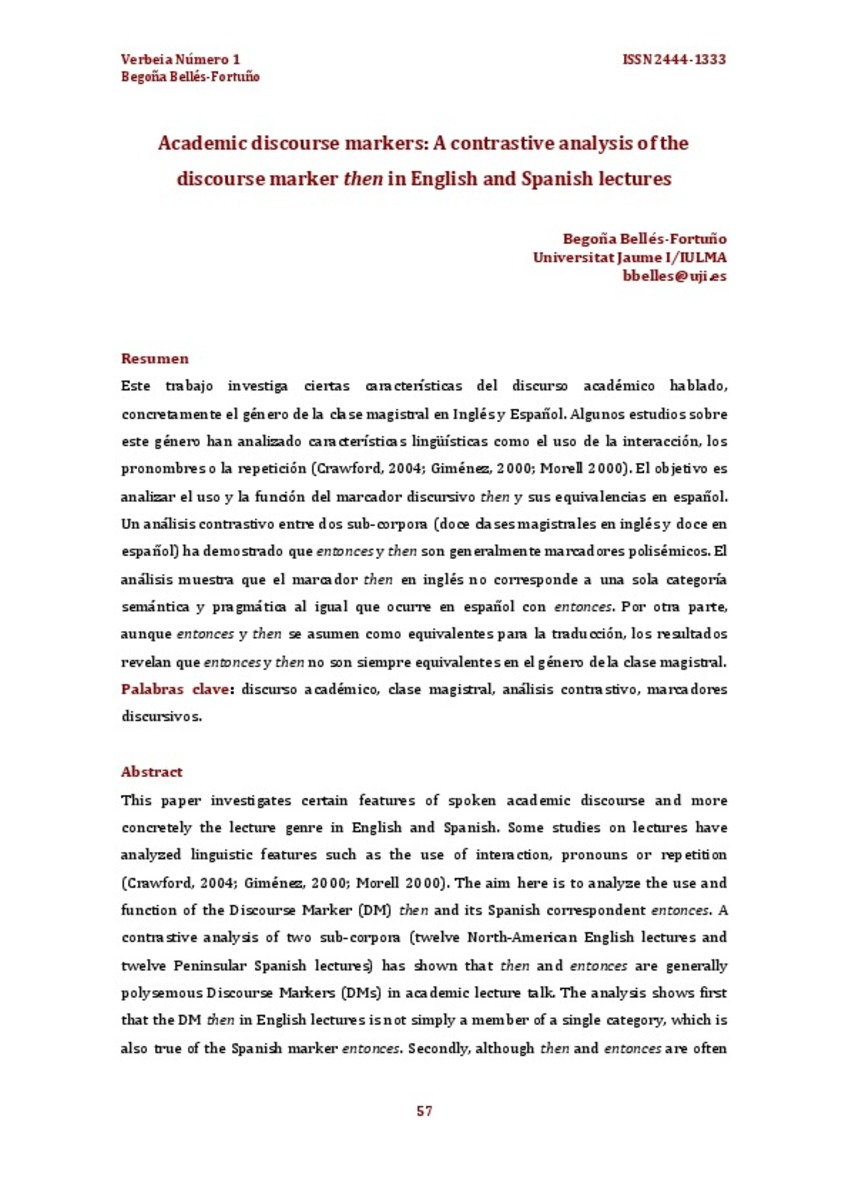Mostrar el registro sencillo del ítem
Academic discourse markers: A contrastive analysis of the discourse marker then in English and Spanish lectures
| dc.contributor.author | Bellés-Fortuño, Begoña | |
| dc.date.accessioned | 2016-10-13T14:42:27Z | |
| dc.date.available | 2016-10-13T14:42:27Z | |
| dc.date.issued | 2016-04 | |
| dc.identifier.issn | 2444-1333 | |
| dc.identifier.uri | http://hdl.handle.net/10234/163593 | |
| dc.description.abstract | Este trabajo investiga ciertas características del discurso académico hablado, concretamente el género de la clase magistral en Inglés y Español. Algunos estudios sobre este género han analizado características lingüísticas como el uso de la interacción, los pronombres o la repetición ( Crawford, 2004; Giménez, 2000; Morell 2000). El objetivo es analizar el uso y la función del marcador discursivo then y sus equivalencias en español. Un análisis contrastivo entre dos sub - corpora (doce clases magistrales en inglés y doce en español) ha dem ostrado que entonces y then son generalmente marcadores polisémicos. El análisis muestra que el marcador then en inglés no corresponde a una sola categoría semántica y pragmática al igual que ocurre en español con entonces . Por otra parte, aunque entonces y then se asumen como equivalentes para la traducción, los resultados revelan que entonces y then no son siempre equivalentes en el género de la clase magistral. | ca_CA |
| dc.description.abstract | This paper investigates certain features of spoken academic discourse and more concretely the lecture genre in English and Spanish. Some studies on lectures have analyzed linguistic features such as the use of interaction, pronouns o r repetition (Crawford, 2004; Giménez, 2000; Morell 2000). The aim here is to analyze the use and function of the Discourse Marker (DM) then and its Spanish correspondent entonces . A contrastive analysis of two sub - corpora (twelve North - American English lectures and twelve Peninsular Spanish lectures) has shown that then and entonces are generally polysemous Discourse Markers (DMs) in academic lecture talk. The analysis shows first that the DM then in English lectures is not simply a member of a single category, which is also true of the Spanish marker entonces . Secondly, although then and entonces are often assumed to be translation equivalents, the findings reveal that then and en tonces cannot function as simple counterparts in English and Spanish lectures. | ca_CA |
| dc.format.extent | 22 p. | ca_CA |
| dc.format.mimetype | application/pdf | ca_CA |
| dc.language.iso | eng | ca_CA |
| dc.publisher | Universidad Camilo José Cela | ca_CA |
| dc.relation.isPartOf | Verbeia. Revista de estudios filológicos, 2016, núm. 1 | ca_CA |
| dc.rights | Universidad Camilo José Cela © 2016 Verbeia es una revista científica internacional de libre acceso que versa sobre los dos campos de la filología. | ca_CA |
| dc.rights.uri | http://rightsstatements.org/vocab/InC/1.0/ | * |
| dc.subject | Discurso académico | ca_CA |
| dc.subject | Clase magistral | ca_CA |
| dc.subject | Análisis contrastivo | ca_CA |
| dc.subject | Marcadores discursivos | ca_CA |
| dc.subject | Academic discourse | ca_CA |
| dc.subject | Lecture talk | ca_CA |
| dc.subject | Contrastive analysis | ca_CA |
| dc.subject | Discourse markers | ca_CA |
| dc.title | Academic discourse markers: A contrastive analysis of the discourse marker then in English and Spanish lectures | ca_CA |
| dc.type | info:eu-repo/semantics/article | ca_CA |
| dc.rights.accessRights | info:eu-repo/semantics/openAccess | ca_CA |
| dc.relation.publisherVersion | http://www.ucjc.edu/book/verbeia-numero-1/ | ca_CA |
| dc.type.version | info:eu-repo/semantics/publishedVersion |
Ficheros en el ítem
Este ítem aparece en la(s) siguiente(s) colección(ones)
-
ANG_Articles [304]







